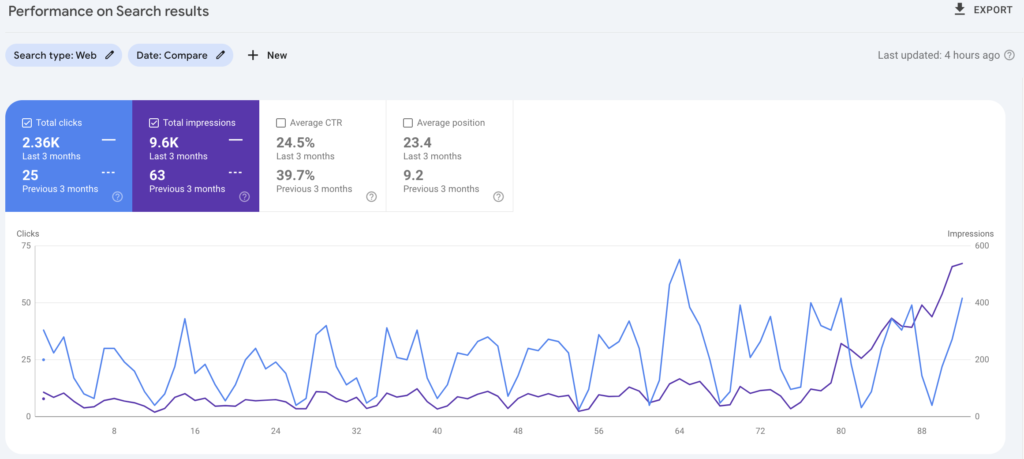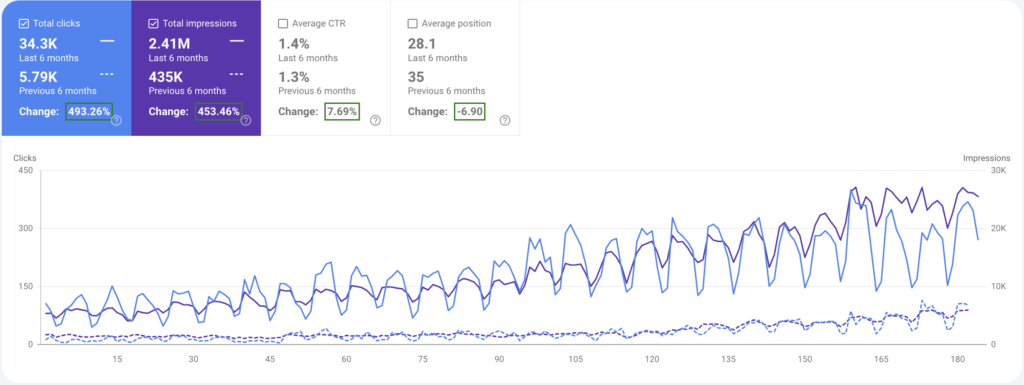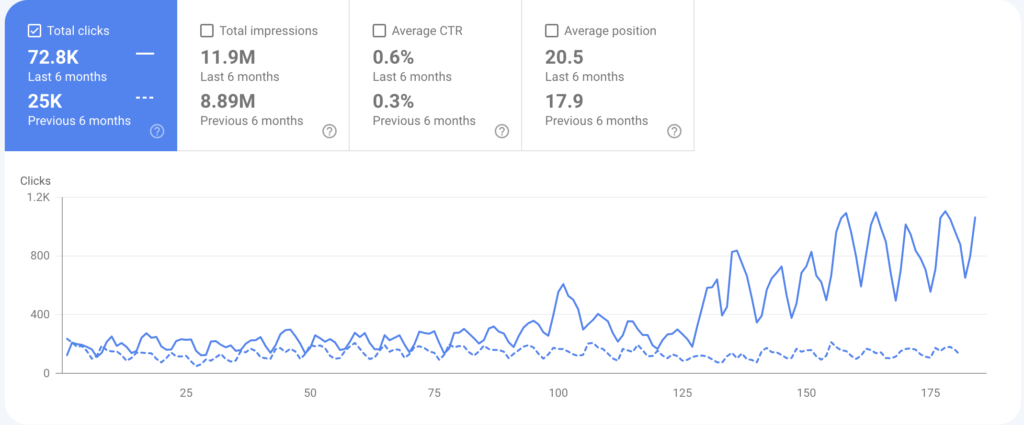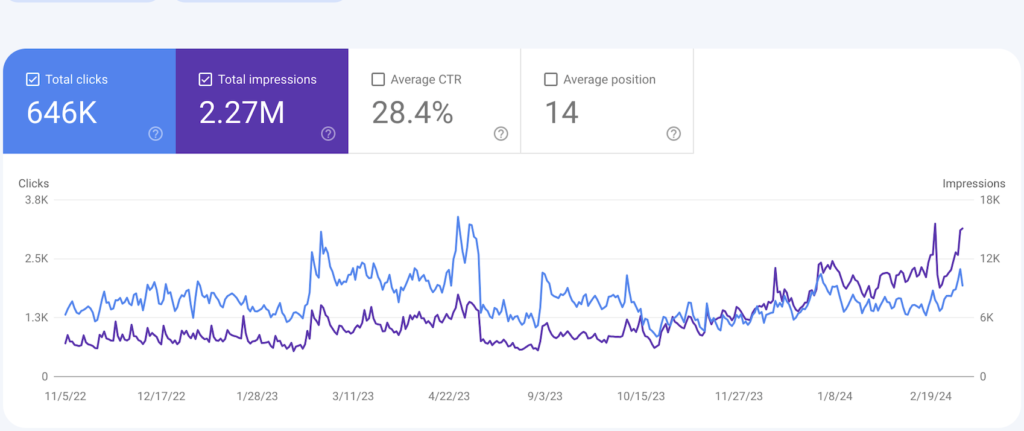Digitization has made businesses realize that ranking their website on the first page of search results has become crucial. A business’s success and growth depend largely on appearing at the top of search results.
A website requires many systematic strategies to appear at the top of the user’s search intent. ThriveCraft strictly follows the SEO Standard Operating Procedures (SOPs), which saves time and boosts productivity.
SEO SOPs are structured guidelines that simplify a complex website ranking process. Including these in our process helps us ensure we incorporate keywords appropriately and do not miss a single step during website ranking.
Are you struggling with low online visibility or poor lead generation? Thrivecraft is a leading platform for properly executing sustainable SEO practices, faster results, and long-term growth.
We provide customized solutions to challenges such as low online visibility, poor lead generation, outdated SEO practices, disconnected SEO and content, and other SEO-related issues.
With modern SEO SOP practices and 100% human-written content, ThriveCraft ensures your business thrives in this competitive digital industry. Let’s understand how we work.
What is the importance of SEO SOPs?
SEO SOPs are essential for a business to keep ranking on top of SERPs. These Standard Operating Procedures (SOPs) are crucial for:
Simplifies Processes
SEO involves several activities, such as keyword research, content optimization, link building, and technical audits. Some SOPs clearly instruct on what to do for each task to ensure a smooth workflow and minimize errors.
Consistency
A structured approach enables teams to repeat successful methodologies from one campaign to another and maintain one quality standard across all campaigns.
Time and Cost Savings
SOPs outline the step-by-step procedure, reduce the time needed to train others, and ensure the team learns without confusion. This increases productivity and ensures that all functions run much more efficiently.
Boost Collaboration
SEO is a cross-functional activity requiring support from content writers, developers, and marketing strategists. The SOP provides material for joint work and development and establishes a common platform for supporting coworkers.
Increased Accountability
This procedure allows tracking performance and ensuring all tasks are completed efficiently within the deadline.
Adapts to Changes
SEO is dynamic, with regular changes to search engine algorithms. SOPs provide flexible frameworks that can accommodate changes relative to industry movements while allowing the smooth operation of processes.
For Improved Performance
Use SOPs to develop action plans, follow logical patterns, and eliminate complex approaches. This can enable businesses to gain higher organic traffic and a higher return on investment.
Key Components of SEO SOP
It requires a well-structured approach while creating an effective SEO SOP covering all critical search engine optimization aspects. Here are the key components of SEO SOP:
The objective of SEO SOPs
Your SEO strategy goals should be clear, such as improving organic traffic, increasing domain authority, or boosting conversion.
Define KPIs demonstrating the strategy’s effect, including keyword rankings, click-through rates, or organic impressions.
Tools for Keyword Research
Tools and techniques for identifying keywords, such as Google Analytics, SEMrush, and others, help find relatable keywords that perform well. These SOPs provide guidelines on keyword intent, monthly volume searches, and competition analysis.
Tips for Content Optimization
These SOPs include best practices for meta titles, meta descriptions, and headers, guidelines for elements of keyword flow within the content, and a checklist for formatting, readability, and mobile optimization of the content.
Detailed Guide on Technical SEO
Comprehensive instructions for performing site audits to check for crawlability and indexability. Provide tips on how to deal with broken links, duplicate content, slow page speed, etc and how to implement schema markup and structured data.
Step-by-Step On-Page SEO Rules
Provide a step-by-step checklist for optimizing URL structure, internal linking, and images for their alt texts. Include tips for Creating good CTAs and optimizing anchor text.
Steps for Off-Page SEO
It helps build quality backlinks like guest blogging or outreach campaigns. Monitor and improve the domain authority.
Detailed Analytics and Reporting
You can practice Google Analytics and Search Console, create traffic, measure ranking, and get proper user engagement reports regularly. Provide a template for analysis to find trends and make data-driven decisions with these essential marketing metrics.
Daily Algorithm Updates and Adjustments
- Protocols are used to receive updates on any search engine’s algorithm change.
- How to evaluate and revise existing tactics based on updates.
Team Collaboration
- Role and responsibility of every member of the team engaging in SEO-related tasks.
- Workflow for content creators, developers and marketing strategists to communicate their job outlook.
List of Required Documentation
- How to track and update the SEO SOP document.
- Documentation should be adopted to permit tracking incremental, gradual changes to allow teams to work based on the latest process changes.
How to Build an SEO SOP Template: Step-by-Step Guide
A comprehensive SEO SOP template enables your team to perform optimization tasks duly, systematically, and resource-efficiently. Use this step-by-step guide to come up with a proper and flexible SEO SOP template:
Step 1: State the Purpose and Goals
State the SOP’s purpose to streamline SEO efforts, improve team efficiency, or maintain consistency.
Target a specific aim for objectives like organic growth—improving ranked keywords or optimizing site performance.
Step 2: Identify Key SEO Processes
List all essential SEO processes involved, such as:
- Research keywords
- Create and optimize content
- Audit technical SEO
- Perform link-building activities
- Track and report performance
Step 3: Break Down the Each Process Into Steps
Explain in a step-by-step manner each action that is to be taken to address a particular task.
For example, keyword research:
- Select keyword research tools (e.g., Google Keyword Planner, Ahrefs).
- Identify seed keywords based on business goals.
- Analyze search volume, keyword difficulty, and intent.
- Compile a list of primary and secondary keywords.
Step 4: Set Tools and Techniques
State the tools and resources for each task. For example, you might use SEMrush to handle audits or Grammarly to check your content. Once you’ve chosen your tools, provide clear instructions on how to use them.
You can even include links to helpful videos or tutorials to make it easier for others to follow. The goal is to ensure everyone knows what to use and how to use it.
Step 5: Set Out Roles and Responsibilities
The part of a particular process to be handled by certain people (e.g., content writer, SEO analyst, web developer) must be defined clearly.
Accountability can be tracked with the help of any project management tool, such as Asana or Trello.
Step 6: Incorporate Checklists and Quality Benchmarks
Create project-oriented checklists, such as content that contains meta tags or images that contain alternative text.
List the quality metrics where word count, reading scores, and loading times come at the top.
Step 7: Include Review and Approval Guidelines
Select review parameters that ensure that quality and adherence to best SEO practices are observed.
Example:
- SEO analyst reviews for keyword usage.
- The developer runs technical SEO changes through tests before going live.
Step 8: Reporting and Feedback Mechanism
Lay out the reporting schedule, weekly or monthly, or whatever works best.
Develop measurable success metrics: organic traffic, bounce rate, or conversion.
Include a loop of feedback for continuous improvement.
Step 9: Create a Scalable and Adaptable SOP
Make the SOP flexible enough to accommodate algorithm changes and industry dynamics.
Consider a versioning system to identify updates and changes.
Step 10: Format and Distribute the Template
Make it readable and easily understood, preferably as a Google Doc or PDF. Break it up with headings and sections for more straightforward navigation.
Share it with the relevant team members and provide a walkthrough session.
Structure of an SEO SOP Template
- Introduction and Objectives
- Tools and Resources
- Task-Specific Steps (e.g., Keyword Research, Content Optimization)
- Roles and Responsibilities
- Checklists and Standards
- Review and Approval Process
- Performance Metrics and Reporting
- Revision History
Following this step-by-step guide, you can create an SEO SOP template that boosts efficiency, ensures consistency, and drives measurable results.
SEO Optimization: Best Practices
Proven SEO optimization techniques are a must-do to ensure your website ranks high in SERPs and draws in organic traffic. Here are some best practices for effective SEO:
Conduct Thorough Keyword Research
Tools such as Google Keyword Planner, Ahrefs, or SEMrush will help you identify high-value keywords with manageable competition.
Focus on long-tail keywords to target specific user intent and improve conversions.
Optimize On-Page Elements
- Write catchy meta titles and descriptions and include target keywords naturally.
- Utilize the correct heading structure (H1, H2, H3) for clarity and keyword placement.
- Optimize image attributes (file names, alt texts, and captions).
- Ensure the URL structure is straight and concise and contains primary keywords in its description.
Create High-Quality Content
- Develop compelling, informative, and original content concerning your audience’s needs.
- Integrate keywords naturally; do not stuff them.
- Keep it updated for continued relevance.
- Add value with choices such as multimedia: images, videos, and infographics.
Maximize Site Speed and Mobile Optimization
- Identify performance issues using tools like Google PageSpeed Insights.
- Optimize images, leverage browser caching, and enable compression to ensure a faster loading time.
- Be sure your site is responsive, providing seamless experiences across devices.
Get Around with Technical SEO
- Using a properly configured robots.txt file and XML sitemaps, ensures your site is crawlable and indexable by search engines.
- Take care of broken links, ensure no duplicate content, and address 404 errors.
- Use schema markup to help search engines understand your content better and improve your eligibility for rich snippets.
Have a Strong Internal Linking Structure
- Link your relevant on-page content to distribute link equity and enhance the user experience.
- Make use of descriptive anchor texts that include target keywords.
Quality Backlinks
- Get backlinks from authoritative and relevant websites through guest blogging, partnerships, outreach, etc.
- Refrain from landing spammy or low-quality backlinks because it will decrease your ranking.
Voice Search and Featured Snippet Optimization
- Use conversational keywords and phrases to target voice search queries.
- Answer common questions simply and concisely to maximize the chances of being revealed in featured snippets.
Ensure Local SEO Optimization
- Optimize your Google My Business profile.
- Use location-specific keywords and ensure consistency in NAP (Name, Address, Phone) for all platforms.
Monitor and Analyze Performance
Analytics like Google Analytics and Google Search Console should be employed to track your server traffic, user behavior, and rankings for the target keywords.
The strategy should change according to analytical measures and insights gained. Search engine ranking algorithms and best practices change constantly. Stay current with industry updates, trends, and guidelines so that your strategies yield long-term results.
This guideline will build a solid fundamental SEO base that will constantly yield traffic, boost an excellent user experience, and enhance visibility.
What is the role of SEO SOPs in Consistent Execution
More Efficient Workflows: SEO SOPs give a defined, structured process for all types of SEO work. This streamline processes, minimizing confusion and avoidable duplicate work.
Consistency between Teams: When SEO SOPs are established, everybody works from the same source. This means there is an opportunity for competitive advantage between content writers, developers, and marketers.
Scalability: SOPs allow newly hired team members to fit right in and grow with your SEO efforts as your business blossoms.
Reduction in Errors: Clear instructions present an excellent chance of reducing errors and ensuring specific tasks are performed with the same level of diligence and care.
Adaptation to Algorithm Changes: An SOP is core material that can be modified according to new search engine algorithms, keeping the SEO effort updated.
SEO SOPs for Technical Optimization
Site Audit Checklist
Regularly check for issues regarding crawlability and indexability using tools like Screaming Frog or SEMrush; repair broken links, duplicate content, and orphaned pages.
Page Speed Optimization
PageSpeed insights to run through the loading time. Focus on compressing images, enabling browser caching, and reducing CSS/JS.
Mobile Optimization
Test mobile optimization with the Google test. Use a responsive design while keeping a proper touch-target size.
Structured Data Implementation
Schema Markup increases visibility on SERPs; schema validation uses Google Rich testing.
A Secure and Accessible Site
Make sure your URL is on HTTPS. Create, update, and maintain an accurate robots.txt file and XML sitemap. SEO SOPs for on-Page SEO
Keyword Placement
Insert target keywords into meta titles, descriptions, headers, and within the first 100 words of the content. Avoid stuffing in keywords and maintain a natural flow.
SEO SOPs for On-Page SEO
Keyword Placement
- The ideal placement for the target keywords is in meta titles, meta descriptions, headers, and the first 100 words of a given piece.
- Do not make it an unnatural keyword stuffing.
Meta Tags Optimization
- Construct an appealing and succinct meta title (50-60 characters) and meta description (150-160 characters) using the target keywords.
URL Structuring
- Work towards simple yet descriptive URLs that are keyword-rich.
- Keep URLs short to preclude them from getting extremely complex.
Internal Linking
- Interlink with at least two related pages within the site.
- Use keyword-rich anchor texts to provide context.
Image Optimization
- Descriptive file names; include relevant keywords in the alt text.
- Compress images without losing the visual quality for faster loading speed.
SEO SOPs for Content Optimization
Content Strategy
- Define audience personas and create customized content to target those personas and corresponding search intent.
- Engage in regular uploading and posting through a content calendar.
Content Quality Checklist
- Original, engaging, and valuable content.
- Properly formatted, it is appealing to the eyes: short paragraphs, subheads, and bulleted text.
Keyword Integration
- Make sure to place your primary and secondary keywords into the text naturally.
- Keywords shall be infused into the various headings (H1, H2, H3) to make the structure and content relevant.
Multimedia Elements
- To promote user engagement, augment your content with multimedia elements such as images, infographics, videos, and charts.
- Provide engaging captions and descriptions for the multimedia elements used in the text.
Call to Action (CTA)
- There are engaging and clear CTAs inviting action, such as sign up, buy, or find out more.
Types of Linking Strategies in SEO SEOPs
External and internal linking strategies are among the most vital within any SEO SOP. They represent how various web pages relate to each other and improve user navigation, and they are an essential factor for ranking in any search engine.
The two general types of linking strategies are internal and external:
Internal Linking Strategy
Linking internally means creating hyperlinks from one web page on your website to another page of your website. This tactic is essential for user experience enhancement, passing link equity, and guiding the crawling bots of search engines through your site structure.
Internal Linking Goals
- The user should download related and connected content while quickly navigating through the website.
- Search engines understand a website’s hierarchy and each web page’s relative importance.
- Aids in passing link equity to the correct pages, improving their chances of scoring high in the results.
Internal Linking Best Practices for SEO SOPs
- Link the content that is helpful for your users to a relevant page of your site.
- Use descriptive and keyword-rich anchor text that conveys what the linked page is about.
- Ensure the site structure is logical and easy to navigate, with no orphan pages.
- Limit the number of internal links on a page. The more links, the more diluted they become.
- Include internal links in your navigation menus, footers, and blog posts for increased visibility.
Examples in Action
- A blog post on “SEO Basics” could link to a related article on “Keyword Research Techniques.”
- An eCommerce product page could link to “Frequently Bought Together” or “Related Products.”
External Linking Strategy
External Linking Strategy
External linking creates hyperlinks from your site to a page on another domain. Although external linking is rarely given enough credit, it is one of the most critical factors in establishing credibility, producing abundant content, and enriching user experience.
Objectives of External Linking
- Provides users with additional references and information.
- Signals to search engines that your content is well-researched and authoritative.
- Establishes relationships with other websites, allowing for opportunities for backlink exchange.
Best Practices for External Linking in SEO SOPs
- Cite authoritative and relevant sources to gain credibility against your content.
- Use descriptive anchor texts that indicate what the linked page is about.
- Ensure the pages are from trusted domains without association with unfriendly practices.
- Create external links that open in a new tab, ensuring the user keeps engaging with your page.
- Regularly audit external links to make sure they are functional and up to date.
Examples in Practice
- A blog about “Digital Marketing Trends” can link to an industry report from Forbes or HubSpot.
- A health and wellness site discussing dietary tips could link to a peer-reviewed study or government guidelines.
Benefits of Linking at a Glance
With a strong internal and external linking strategy, you can ensure that your SEO SOPs increase site navigation and add value to your content’s ranking.
When effective external linking strategies are appropriately applied, they will form the building blocks for a fantastic linking profile for your website and a better user experience.
Common Mistakes to Avoid in SEO SOPs
While SEO SOPs are crucial for consistent and effective optimization, Overdoing or mis-implementation can lead to errors that hinder performance.
Avoid these common mistakes to ensure your SEO SOPs are effective and aligned with your objective.
Outdated SOPs
SEO changes daily with engine algorithm updates, changes in consumer behavior, and industry trends. Not updating your SEO SOPs can mean using outdated practices that are less effective.
Lack of Customization
Applying generic SOPs without customization can lead to bad strategies. Instead, tailor your SOPs to meet your website, audience, or industry’s specific goals, obstacles, and opportunities.
Technical SEO
Not addressing technical SEO issues such as slow page speed, crawl errors, broken links, and poor mobile response can result in optimization failures. Incorporate a definitive checklist for technical audits and solutions in your SOPs.
Keywords Stuffing
Keyword stuffing or misplaced keyword usage within content can demote your rankings. Ensure your SOP emphasizes a natural and strategic keyword integration approach in Meta tags, headlines, and body copy without compromising readability.
Link Quality
In SEO, quality over quantity is essential when linking. If internal links are well executed and linked sites have high authority, your site’s credibility will be protected.
Failure to Monitor Performance
Leaving out KPIs and analytics from your SOP means you’re shooting blind when monitoring your strategies. Be sure to include a constant performance diagnostic through different SEO SaaS tools.
Ignoring User-Focused Content
Don’t create SOPs that ONLY focus on search engine rankings, insisting on putting engaging, valuable, user-centric content first.
Leaving out Mobile and Voice Search
Ensure that your SOPs address mobile optimization and include strategies for targeting voice search queries with conversational keywords and structured data.
Inconsistent Implementation
SOPs work only if they are correctly executed. Maintain uniformity through team member training and ensure adherence to the prescribed procedures.
By avoiding these common mistakes, you can make your SEO SOPs more effective, improve search engine rankings, and provide a seamless user experience. A well-maintained and adaptable SOP is a cornerstone of any successful SEO strategy.
Why Hire Us?
At ThriveCraft, we understand that SEO is crucial for businesses and startups. We offer customized solutions that provide measurable results and strengthen your digital presence. By choosing us as your SEO partner, you are investing in an expert team that has the motivation and innovative vision for your business success.
Our experts constantly innovate using the industry’s most advanced tools, techniques, and research. Our services cover every aspect of SEO, from deeper keyword exploration and technical audits to user-oriented content writing and high-impact link-building strategies.
Choose ThriveCraft to move faster towards your online success and realize that investing in Us is investing in you. The road to growth starts with getting in touch with us.
Frequently Asked Questions (FAQs):
What Tools Help Identify Broken Links Efficiently?
Tools like Ahrefs, Screaming Frog SEO Spider, Sitechecker, SEMrush, W3C Link Checker, and Dead Link Checker are widely used to efficiently identify broken links on a website.
Why Is Fixing Broken Links Important for SEO?
Fixing broken links is important for SEO because they negatively impact the user experience by leading to error pages when clicked, which can increase bounce rate, ultimately signaling to search engines that your website is of lower quality and affecting your search rankings.
How Often Should SEO Optimization Be Reviewed?
According to most SEO experts, you should review your SEO optimization strategy at least every 3-6 months.
Can External Linking Boost Domain Authority?
This can be a powerful tool in search engine optimization (SEO), as it can help increase your site’s authority and credibility in search engines.








